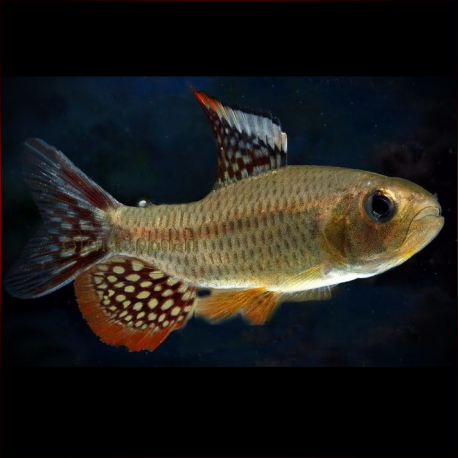More info
Datasheet
| Minimum Tank Size | 90 litres / 23.78 US gallons |
| Maximum Size | 7.0cm / 2.76inches |
| Temperature | 20°C / 68.00°F - 28°C / 82.40°F |
| Hardness | 1.01dgH / 18ppm - 5.04dgH / 90ppm |
| pH | 4.0-6.5 |
General Description
The Crenuchus Spilurus, commonly known as the Sailfin Characin, is the sole described member of its genus, displaying varying color patterns and morphologies across its native range. Belonging to the Crenuchidae family, it is distinguished by possessing paired foramina in the frontal bones. This species is primarily found in forest streams, flooded forests, and minor tributaries, usually characterized by overhanging riparian vegetation and tea-colored water due to organic matter. Its size can reach up to 7.0cm, with significant variation in adult size across its distribution.
Aquarium Setup
When maintaining Crenuchus Spilurus, it is recommended to use a well-structured aquarium setup with sandy substrate, driftwood, and branches. Including dried leaf litter enhances the natural environment, provides cover, and fosters microbe colonies. The addition of aquatic plant species that can thrive in dim lighting, like Microsorum and Cryptocoryne spp., is beneficial. Floating vegetation, particularly Ceratopteris spp., is also advantageous. It's crucial to ensure stable water conditions with a pH of 4.0-6.5, hardness of 18-90ppm, and a temperature range of 20-28°C. Avoid introducing this species to biologically immature aquariums due to its sensitivity to organic waste fluctuations.
Behaviour
This characin species is generally peaceful with other species, but due to its timid nature and benthic lifestyle, it may not be the ideal community fish. It is recommended to keep Crenuchus Spilurus alone or with similarly-sized non-aggressive characids, small callichthyid, or loricariid catfish. Adult males can become territorial during the breeding period, focusing on protecting their territory with minimal physical harm, given sufficient cover and broken lines-of-sight.
Feeding and Diet
The Sailfin Characin primarily feeds on tiny invertebrates and zooplankton in the wild, including larvae, copepods, and ostracods. In captivity, they may accept dried foods but thrive on small live or frozen fare such as Artemia nauplii, Daphnia, and grindal worms. Offering daily meals of varied live and frozen food is ideal to ensure proper nutrition and health.
Reproduction & Dimorphism
For reproduction, Crenuchus Spilurus typically spawns in small caves or leaf litter, with males forming temporary territories to attract females. The male is responsible for guarding the eggs and fry, with incubation lasting 36-48 hours. Newly hatched fry can be fed with brine shrimp or microworms. Adult males exhibit sexual dimorphism, being larger, more colorful, and developing elongated dorsal and anal fins, while females are comparatively plain.
Habitat and Distribution
The Sailfin Characin's type locality is in the Essequibo river system in Guyana, but it is widely distributed across the Amazon and Orinoco drainage systems and coastal rivers of Guyana, French Guiana, and Suriname. This species thrives in forest streams, flooded areas, and tributaries with abundant vegetation, fallen branches, tree roots, and leaf litter covering the substrate.

